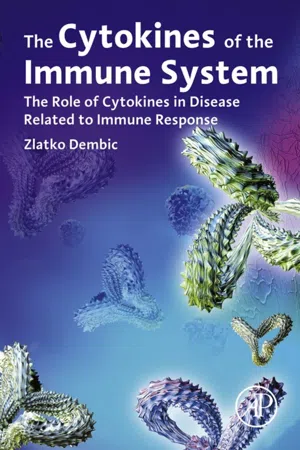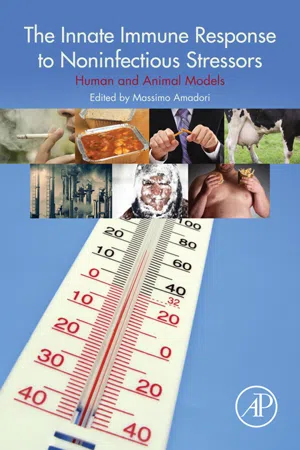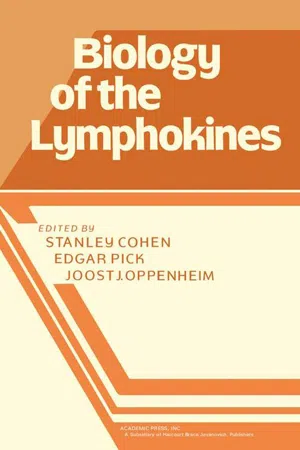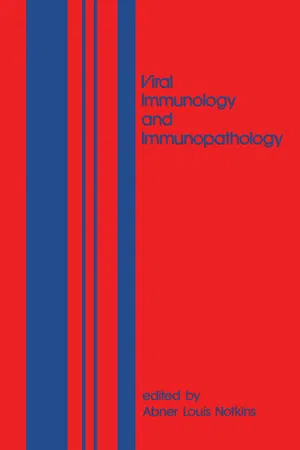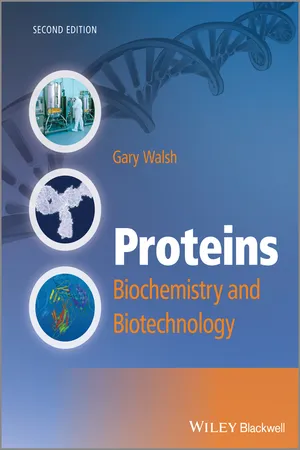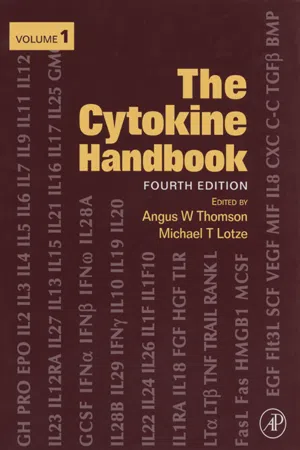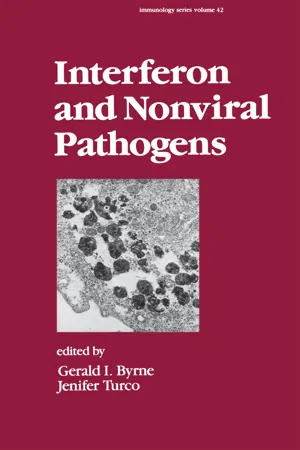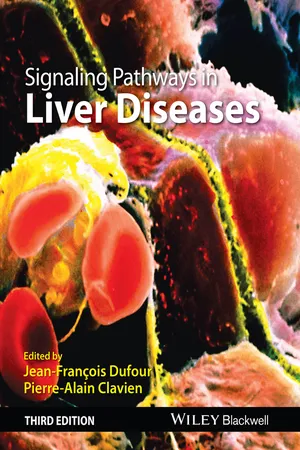Biological Sciences
Interferon
Interferon is a group of signaling proteins produced by the body in response to viral infections, tumors, and other immune challenges. It plays a crucial role in regulating the immune system and has antiviral, antiproliferative, and immunomodulatory effects. Interferon can be used therapeutically to treat certain diseases, including hepatitis C, multiple sclerosis, and certain cancers.
Written by Perlego with AI-assistance
Related key terms
Related key terms
1 of 4
Related key terms
1 of 3
10 Key excerpts on "Interferon"
- eBook - ePub
The Cytokines of the Immune System
The Role of Cytokines in Disease Related to Immune Response
- Zlatko Dembic(Author)
- 2015(Publication Date)
- Academic Press(Publisher)
Chapter 5Cytokines of the Immune System
Interferons
Abstract
Interferons were initially defined as a group of cytokines produced by any type of cell in the body in response to viral infection. Their essential link with the innate and adaptive immune system has been established only recently to the full extent in that they are necessary for the successful anti-viral and anti-bacterial immune defense. Three types of Interferons are mentioned with respect to their structure and function. Type I Interferons (a group consisting of Interferons α/β/ω and τ) and type II (Interferon-γ) are described for their role in immunologic reactions, association with various diseases and their therapeutic potential. Type III Interferons (Interferon-λ), also named interleukin-28 and -29, are described in Chapter 6 , Interleukins.Keywords
Association with diseases; Interferons-α/β; Interferon-γ (IFN-γ); Interferon-λs (IL-28, -29); Receptors; SNPsCytokines stimulate, influence and control growth, development, survival, and effector functions of cells of hematopoietic tissues. They are divided into families of regulatory molecules such as Interferons, interleukins, chemokines, growth factors, and colony stimulating factors according to historical view of their function.Interferons are proteins (divided in three types) that act on neighboring cells stimulating intracellular defense against viruses. Interferon-α, -β, -γ, and -λ (IFN-α, IFN-β, IFN-γ, and IFN-λ) are produced in response to viral infections, and directly affect the uninfected neighboring cells preventing replication of some viruses. However, apart from that role, Interferons have a function in the regulation of immune responses. Most prominent is IFN-γ, as it activates phagocytic cells like macrophages in somatic tissues. Activated macrophages can destroy all the bacteria around them as well as those who live in them (Leishmania, Salmonella, Mycobacteria - eBook - ePub
The Innate Immune Response to Noninfectious Stressors
Human and Animal Models
- Massimo Amadori(Author)
- 2016(Publication Date)
- Academic Press(Publisher)
They are named after the ability to interfere with viral infections of animal cells. Yet, after the serendipitous discovery of their antiviral activity, 1 IFNs were shown to exert a plethora of regulatory, and effector biological functions. Thus, IFNs can affect cell proliferation, differentiation, and also play a pivotal role in the innate immune system and in the regulation of the adaptive immune response. 2 IFNs can modulate the balance between pro- and antiinflammatory mediators secreted by T lymphocytes and antigen-presenting cells, which may be associated with detrimental or beneficial effects for the host. 3 To date, three distinct categories of IFN molecules are known, that is, types I, II, and III IFNs - eBook - ePub
- J.S. Oxford(Author)
- 2018(Publication Date)
- CRC Press(Publisher)
17 Such a finding could be of clinical importance for therapy of acute virus diseases late in the course of infection.FIGURE 1. Summary of the biological requirements for induction of the antiviral state by Interferon. Interferon is thought to bind to a receptor on the external cell surface, initiating unknown event(s) whereby one or more “antiviral proteins” are induced in a process involving the cell nucleus. The antiviral protein(s) inhibit virus replication by interfering with one or more steps in virus macromolecular synthesis. The host genome codes for both the Interferon receptor and the antiviral protein(s), and different chromosomes may be involved in these two functions.III. DISCRIMINATION BETWEEN VIRUS AND HOST CELL FUNCTIONSA very significant property of Interferon, which needs to be understood before its mechanism of action can be fully explained, is its ability in some situations to distinguish between viral and host cell functions. It is important to remember that, although Interferon-treated infected cells will not support virus growth, Interferon-treated uninfected cells usually continue to produce new protein and grow at almost the normal rate;18 in other words, Interferon is not a toxic agent. It has also been shown that induction of new cellular functions such as enzyme synthesis in uninfected cells is far less sensitive to inhibition by Interferon than is the replication of viruses in the same cell type.19 , 20 For example, synthesis of tyrosine aminotransferase in rat hepatoma cells in response to glucocorticoid hormones is partially inhibited only by a several-hundred-fold greater concentration of Interferon than is required for comparable inhibition of vesicular stomatitis or reovirus multiplication.19 Discrimination between virus and host functions can be observed within a single cell population if infection with the virus does not itself immediately affect activities in the host cell. Gupta et al.21 - eBook - ePub
- Stanley Cohen, Edgar Pick, Joost J. Oppenheim, Stanley Cohen, Edgar Pick, Joost J. Oppenheim(Authors)
- 2013(Publication Date)
- Academic Press(Publisher)
et al ., 1977). Therefore, in considering Interferon as a lymphokine, or product of lymphocytes, it is necessary to discuss both classical and immune Interferons. Thus in this chapter we will compare classical and immune Interferon with regard to production, characterization, mechanism of action, role as an antiviral agent, effects on the immune response, and other nonantiviral effects. We shall also discuss clinical studies investigating either the production of classical or immune Interferon as a measure of the competence of the producing cell type or the use of classical Interferon as a therapeutic agent.It is the author’s hope that this chapter will focus attention on the following principles concerning Interferon: (1) Interferon is not a single substance but rather, a family of glycoproteins, known now as “the Interferons.” (2) Interferons have widely diverse effects on the cell biology of a wide variety of cells in addition to their ability to confer protection on cells against viruses. These include immunoregulatory and antiproliferative properties. (3) Interferon is an integral part of the immune response but its role as such is just now coming under close scrutiny in several laboratories. (4) Interferons can be induced by many agents in addition to viruses and can be produced by many cell types in addition to those in the reticuloendothelial system. (5) The type of Interferon produced in response to a given stimulus is not always predictable and can be influenced by the method of preparation of the cells to be examined in culture, the nature of the accessory cells in the culture, or, for in vivo - eBook - ePub
- Abner Louis Notkins(Author)
- 2014(Publication Date)
- Academic Press(Publisher)
For many years antibody was considered the host’s major defense mechanism against viral infections. The interaction of antibody with extracellular virus neutralizes virus, thereby preventing infection of new cells. In the late 1950’s a second host defense mechanism, Interferon, was discovered. This substance acts at the level of the cell and prevents viral replication by inhibiting transcription and/or translation. In the 1960’s a third host defense mechanism, cellular immunity, was identified. Immune lymphocytes are thought to recognize viral induced antigens on the surface of infected cells, and reject these cells in much the same way that immune lymphocytes recognize and reject tumor cells. Over the last few years it has become apparent that a wide variety of biological mediators are released from immune lymphocytes when they are stimulated by specific antigens. One of these mediators is Interferon. The purpose of this review is to bring together information suggesting that the cellular immune response to certain viral infections may be mediated through Interferon.Immune Specific Induction of Interferon in Vitro
In 1965 Wheelock showed that human leukocyte cultures stimulated by phytohemagglutinin (PHA) not only underwent blastogenesis but also produced Interferon (1 ). When compared to standard Interferon induced by incubating leukocyte cultures with Newcastle disease virus (NDV), the PHA-induced Interferon differed in two respects; it was not stable at pH 2.0 and it lost biological activity at 56° C. Subsequently a variety of other mitogens including pokeweed mitogen (PWM) and concanavallin A were found to be capable of inducing the production of Interferon (2 –4 ). In addition, Falcoff et al. found that stimulation of lymphocytes by anti-lymphocyte immunoglobulin resulted in the production of Interferon (5 ).The specific induction of Interferon from immune leukocytes by non-viral antigens was first demonstrated by Green et al. (3 - eBook - ePub
Pharmaceutical Biotechnology
Concepts and Applications
- Gary Walsh(Author)
- 2013(Publication Date)
- Wiley(Publisher)
IFN-γ also directly modulates the immune response by affecting growth, differentiation and function of both T- and B-lymphocytes. These effects are quite complex and are often influenced by additional cytokines. IFN-γ acts as a growth factor in an autocrine manner for some T cell sub-populations, and it is capable of suppressing growth of other T cell types. It appears to have an inhibitory effect on development of immature B-lymphocyte populations, but it may support mature B cell survival. It can both up-regulate and down-regulate antibody production under various circumstances.All Interferons promote increased surface expression of class I MHC antigens. Class II MHC antigen expression is stimulated mainly by IFN-γ (MHC proteins are found on the surface of various cell types. They play an essential role in triggering an effective immune response against not only foreign antigen, but also altered host cells). Although many Interferons promote synergistic effects, some instances are known where two or more Interferons can oppose each other’s biological activities. IFN-αJ, for example, can inhibit the IFN-αA-mediated stimulation of NK cells.The molecular basis by which Interferons promote their characteristic effects, in particular antiviral activity, is understood at least in part. Interferon stimulation of the JAK–STAT pathway induces synthesis of at least 30 different gene products, many of which cooperate to inhibit viral replication. These antiviral gene products are generally enzymes, the most important of which are 2′–5′ oligoadenylate synthetase (2,5-An synthetase) and the eIF-2α protein kinase.These intracellular enzymes remain in an inactive state after their initial induction. They are activated only when the cell comes under viral attack, and their activation can inhibit viral replication in that cell. The 2,5-An synthetase acts in concert with two additional enzymes, i.e. an endoribonuclease and a phosphodiesterase, to promote and regulate the antiviral state (Figure 8.4 - eBook - ePub
Proteins
Biochemistry and Biotechnology
- Gary Walsh(Author)
- 2014(Publication Date)
- Wiley-Blackwell(Publisher)
IFN-α and IFN-β bind the same cell-surface receptor and are both acid-stable. These are collectively termed type I Interferons. IFN-γ is acid-labile and binds to a distinct receptor molecule. This Interferon has been termed type II Interferon. More recently, a type III Interferon subgroup has also been recognized, the IFN-λs, of which three members exist (λ1, λ2 and λ3). These were originally classified as interleukins, and are also known as interleukin (IL)-29, IL-28A and IL-28B, respectively. IFN-λs share only limited homology (~20%) with other type I Interferons and are structurally more closely aligned with the interleukins. However, they bind to a type I Interferon-like receptor, signal transduction is mediated via the JAK-STAT pathway, and they display antiviral and antiproliferative activities.Two additional members of the Interferon family have been identified: IFN-ω and IFN-τ. Both are classified as type I Interferons. An overview summary of the biology of Interferons is presented in Tables 9.2 and 9.3 .Human Interferons and the cellular sources from which they were initially isolated.Table 9.2Interferon type Additional name Cell type from which initially isolated/produced Alpha Interferons (at least 12 distinct but related types exist) Leukocyte Interferon, lymphoblastoid Interferon Leukocytes or lymphoblastoid cells Beta Interferon Fibroblast Interferon Fibroblasts Gamma Interferon Immune Interferon Activated T lymphocytes Lambda Interferon (three members) IL-29, IL-28A, IL-28B T lymphocytes, virus-infected cells, dendritic cells Summary of the biological characteristics of the Interferons. Details provided relate to human Interferons, except in the case of IFN-τ, which is only produced by ruminants.Table 9.3Interferon Amino acids Molecular mass (kDa) Glycosylated? Major cellular sources Major biological activities α (multiple) Usually 166 16–27 Some are Lymphocytes, monocytes, macrophages Confers target cells with viral resistance. Inhibits proliferation of various cell types. Regulates expression of MHC class 1 antigens β 166 20 No Fibroblasts, epithelial cells Similar to those of IFN-αs γ 143 40–70 Yes T lymphocytes, NK cells Regulates all phases of the immune and inflammatory response. Displays only weak antiviral and antiproliferative activity λ 181 (λ1) 175 (λ2, λ3) 20 Only λ1 T lymphocytes Broadly similar to type 1 IFNs, in particular antiviral activity ω 172 20 Yes Mainly leukocytes Similar to those of other type I Interferons τ 172 19 No Trophoblast cells Sustains the corpus luteum during the early stages of pregnancy. In addition, displays the major biological activities of other type I Interferons - eBook - ePub
- Angus W. Thomson, Michael T. Lotze(Authors)
- 2003(Publication Date)
- Academic Press(Publisher)
CHAPTER 23 Type I Interferons [IFNα, β, δ, K, ω, ι, IL-28A (IFNλ2) IL-28B (IFNλ3) and IL-29 (IFNλl)] Jeanne M. Soos and Brian E. Szente, GlaxoSmithKline Pharmaceuticals, King of Prussia, PA, USA If we will only allow that, as we progress, we remain unsure, we will leave opportunities for alternatives. We will not become enthusiastic for the fact, the knowledge, the absolute truth of the day, but remain always uncertain … In order to make progress, one must leave the door to the unknown ajar. Richard P. Feynman (1918-1988) INTRODUCTION The activity for which the Interferons, and in particular the type I Interferons received their name, was identified by Isaacs and Lindenmann in 1957. In chick chorioallantoic membranes, they observed a marked inhibition of the replication of influenza virus, and thus began the field of Interferon research (Isaacs and Lindenmann, 1957). Since that time, our understanding of the nature and biology of Interferons has grown substantially to the point such that the cellular receptors for the Interferons have been identified, and some of the intracellular signaling cascades of which they make use. Natural and recombinant Interferons a and β are now approved as effective therapies for a number of conditions, including a variety of hematologic and non-hematologic malignancies, hepatitis and papilloma virus infections, and multiple sclerosis. SUBTYPES OF TYPE I IFN The first classification of the IFNs was defined based on the cellular sources of these proteins– namely leukocyte, fibroblast and immune Interferons (Johnson et al., 1994). As the naming schemes were refined based on biology, the leukocyte and fibroblast IFNs were grouped together as type I IFNs and the immune IFN received the designation of type II IFN. The current IFN nomenclature is based primarily on the specific nucleotide sequences of individual IFN genes and groups of IFN genes - eBook - ePub
- Gerald. I. Bryne, Jenifer Turco(Authors)
- 2021(Publication Date)
- CRC Press(Publisher)
THE Interferon SYSTEMPassage contains an image
1Interferons and Their InductionJoseph M. Carlin / University of Wisconsin Medical School, Madison, WisconsinErnest C. Borden / University of Wisconsin Clinical Cancer Center, Madison, WisconsinI. INTRODUCTION
Since the original demonstration of Interferon by Issacs and Lindenmann (1 ) 30 years ago, in which a factor released by chicken egg chorioallantoic membranes exposed to heat-inactivated influenza virus was shown to inhibit the replication of live virus, the complexity and impact of the Interferon system has expanded substantially. Several excellent reviews (2 -5 ) have been written concerning inter-ferons and their physical characteristics, inducers and mechanisms of induction, mechanisms of regulation of production, genetics, and their biological activities. Since an all-inclusive review of the Interferon system is beyond the scope of this chapter, its purpose will be to present a general overview of Interferons and their induction processes.II. PHYSICAL CHARACTERISTICS OF InterferonS
Interferons are defined as inducible proteins that inhibit viral replication. Additional characteristics which serve to distinguish Interferons from antibodies and nonspecific inhibitors of viral growth include several biological and physico-chemical criteria (Table 1 ). Interferons are divided into three main classes, α, β, and γ (Table 2 ). Although immunologically distinct, the type I Interferons, Interferon α and Interferon β, share many characteristics and have been shown to be physicochemically related (7 ), with approximately 30% shared amino acid sequence and with 46% DNA sequence homology. It is speculated that these two Interferon classes arose from a common ancestral gene 5-10 × 10s years ago. Interferon γ (type II) is both antigenically and genetically distinct from type I Interferons (8 ,9 ) although a common evolutionary ancestor for type I and type II Interferons has been proposed (10 - eBook - ePub
- Jean-Francois Dufour, Pierre-Alain Clavien, Jean-Francois Dufour, Pierre-Alain Clavien(Authors)
- 2015(Publication Date)
- Wiley-Blackwell(Publisher)
CHAPTER 16 Interferon signaling Markus H. HeimDivision of Gastroenterology and Hepatology, University Hospital Basel, Basel, SwitzerlandKEY POINTS
- Interferons are currently classified into three groups: type I, type II, and type III.
- Induction and secretion of IFNs result in an autocrine and paracrine positive amplification loop through the activation of the Jak-STAT pathway.
- There are several negative regulators of Interferon signaling such as SOCS, USP18, PiAS, and TcPTP.
- Stimulation of cells with type I IFNs usually leads to the induction of several hundred genes (IFN-stimulated genes, ISGs), but there are also some genes that are negatively regulated by IFNs.
- Continuous exposure to IFN results in a “desensitization” characterized by a return to pretreatment levels of ISG transcription.
- Exposure to type I IFN establishes an “antiviral state” in the cells. The term “antiviral state” implies protection of the cell against viral infection. Type I IFN is used in the treatment of chronic viral hepatitis.
Interferons
Interferon (IFN) was identified more than 50 years ago by Isaacs and Lindenmann during their studies of the phenomenon of viral interference, the ability of an active or inactivated virus to interfere with the growth of an unrelated virus [1]. Today, more than 10 mammalian IFN species and numerous subspecies have been discovered, each with individual properties but all having antiviral activity [2]. They are currently classified into three groups: type I, type II, and type III IFNs. The type I IFNs include all IFN-αs, IFN-β, IFN-ε, IFN-κ, IFN-ω, and IFN-ν [3]. Humans have 12 different IFN-αs and a single IFN-β. Type I IFN genes are clustered on the human chromosome 9. Each subtype is encoded by its own gene and regulated by its own promoter, and none of them contain introns [3]. The different IFN-αs and IFN-β have substantial differences in their specific antiviral activities and in the ratios of antiviral to antiproliferative activities. However, the molecular basis of these differences is not yet known. All type I IFNs bind to the same IFN-α/β receptor (IFNAR) that consists of two major subunits: IFNAR1 (the α subunit in the older literature) [4] and IFNAR2c (the βL subunit) [5,6].
Index pages curate the most relevant extracts from our library of academic textbooks. They’ve been created using an in-house natural language model (NLM), each adding context and meaning to key research topics.
Explore more topic indexes
Explore more topic indexes
1 of 6
Explore more topic indexes
1 of 4
